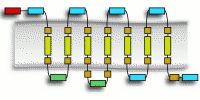
|
GPCRHMM
A GPCR detection method
|

|
Instructions
This server predicts G protein-coupled receptors from amino acid
sequence.
GPCRHMM is described in
Markus Wistrand*, Lukas Käll* and Erik L.L. Sonnhammer.
A general model of G protein-coupled receptor sequences and its application to detect remote homologs.
Protein Science, 15 (3):509-21, Mars 2006.
*These authors contributed equally to this work.



Input
The program takes proteins in FASTA format. It recognizes the 20
amino acids and B, Z, and X, which are all treated equally as
unknown. Any other character is changed to X, so please make sure the
sequences are sensible proteins.
This is an example (one protein):
>EBI2_HUMAN P32249 [Homo sapiens (human)] EBV-induced G protein-coupled receptor 2 (EBI2).
MDIQMANNFTPPSATPQGNDCDLYAHHSTARIVMPLHYSLVFIIGLVGNLLALVVIVQNR
KKINSTTLYSTNLVISDILFTTALPTRIAYYAMGFDWRIGDALCRITALVFYINTYAGVN
FMTCLSIDRFIAVVHPLRYNKIKRIEHAKGVCIFVWILVFAQTLPLLINPMSKQEAERIT
CMEYPNFEETKSLPWILLGACFIGYVLPLIIILICYSQICCKLFRTAKQNPLTEKSGVNK
KALNTIILIIVVFVLCFTPYHVAIIQHMIKKLRFSNFLECSQRHSFQISLHFTVCLMNFN
CCMDPFIYFFACKGYKRKVMRMLKRQVSVSISSAVKSAPEENSREMTETQMMIHSKSSNG
K
GPCR detection
The main usage of the server is to detect putative GPCRs in from amino acid sequence.
Either give the name of the local file in which you have the proteins
in the, or paste the sequence(s) into the input form.
If you paste; make sure that the first line of each entry (the identifier) is not broken.
There is a global and a local score (explained below). The local score
is only calculated for the proteins that have a global score higher
than a threshold of 0. To only use global scoring is faster,
but tend to accumulate false positives.
Global/Local score
GPCRHMM is based on a hidden Markov model that mimics the common topology of
GPCRs: they all span the membrane sevenfold. Global scoring takes
the sequence through the entire model, including the N- and C-terminal
sections. The reported score is calculated using the forward algorithm.
Local scoring takes the subsequence that spans the 1st-7th
TM-helix (as predicted by the 1-best algorithm using the global model). The subsequence is scored to a core
model that only have compartments corresponding to the 1st-7th
TM-helix (forward algorithm). The local score can detect false positives that don't fit the model
well, but which have long N- or C-terminal regions that accumulate
score because of biased sequence composition.
Output
Output is global score, local score and a prediction (GPCR/no).
All reported scores are log-odds scores related to a null model. The
null model reflects the amino acid composition in SwissProt.
Prediction of GPCR transmembrane segment localization
An alternative usage of the server is to localize the transmembrane segments of known GPCRs. This will be done by restricting the predictions
to a GPCR model. The prediction will hence allways contain seven transmembrane segments.






